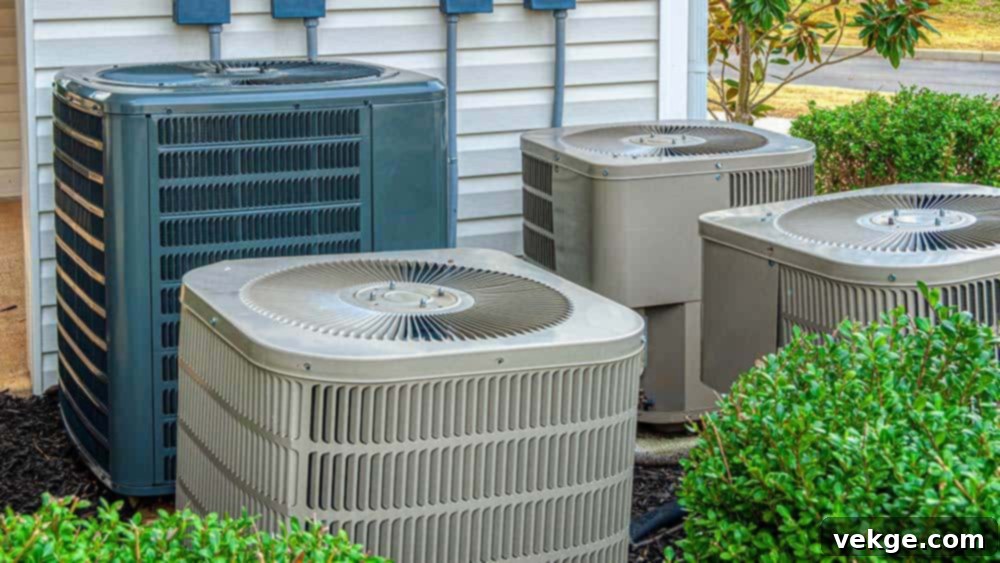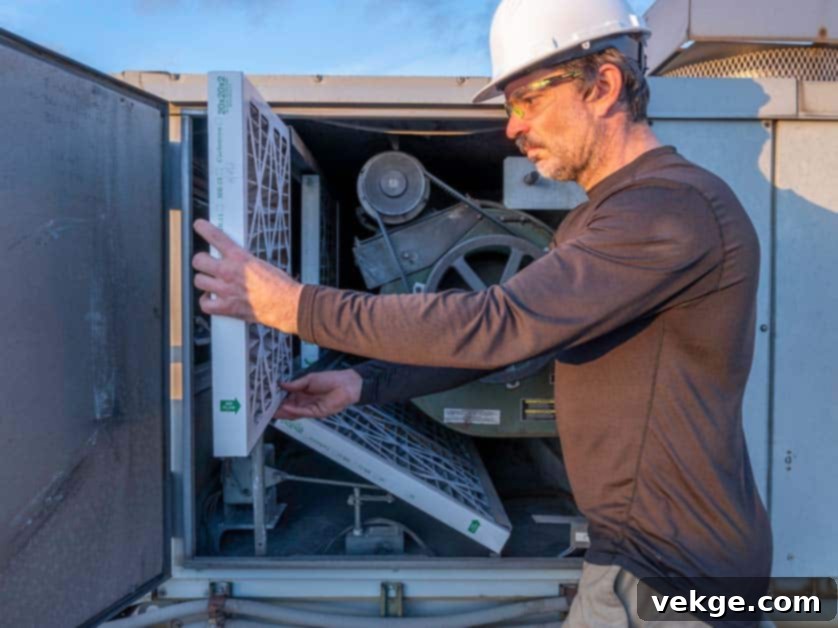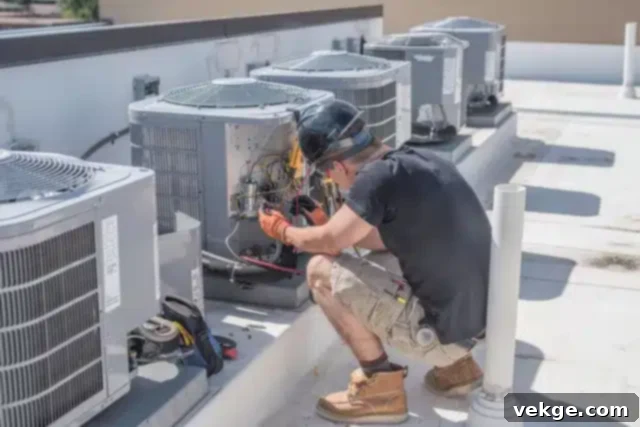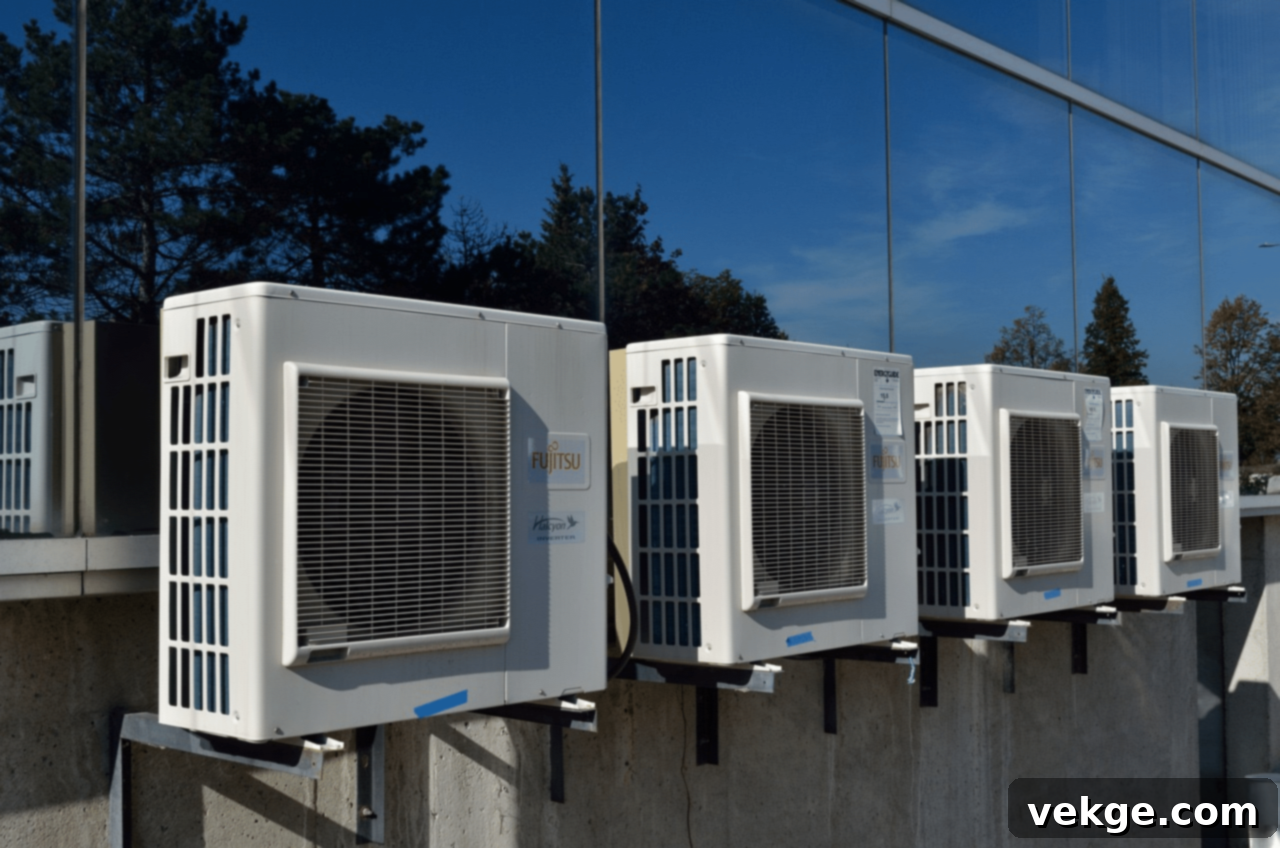Ultimate Guide to HVAC Maintenance: Extend Your System’s Lifespan and Boost Efficiency
Ensuring your heating, ventilation, and air conditioning (HVAC) system operates efficiently for years requires consistent and thorough maintenance. Regular HVAC system care is not just about avoiding sudden breakdowns; it’s a proactive strategy to significantly reduce your energy bills, prevent expensive emergency repairs, and maintain a comfortable indoor environment. This comprehensive guide will equip you with the essential knowledge and practical methods needed for performing routine HVAC maintenance, empowering you to handle many aspects of its functionality and productivity. With a commitment to simple dedication and a bit of care, you can enjoy proficient cooling in summer and reliable heating in winter from your HVAC system for an extended lifespan.
Understanding Your HVAC System: Components and Core Functions

To effectively maintain your HVAC system, it’s crucial to first understand its core components and how they work together. The HVAC system components are primarily divided into three interconnected parts: heating, ventilation, and air conditioning. Each plays a vital role in regulating your home’s indoor climate.
The Heating Element: Keeping You Warm
In most traditional HVAC systems, the furnace serves as the primary heating element. It generates heat, typically by burning natural gas, propane, or using electricity, which is then dispersed throughout the building via a network of ductwork. Alternatively, during colder seasons, a heat pump can function as a highly efficient heating element. It extracts heat from the outside air, even in surprisingly cool temperatures, and transfers it inside your home. Understanding how your specific heating element operates is the first step in ensuring its optimal performance and longevity.
Ventilation: Circulating Fresh, Conditioned Air
Ventilation is critical for distributing conditioned air and maintaining indoor air quality. It involves an intricate network of interconnected ducts that channel treated air from the main HVAC unit to every room in your house. Through supply vents or registers, the conditioned air is circulated, allowing it to enter and enrich your living spaces. The Air Handling Unit (AHU) is central to this process, housing blower fans that drive air through these ducts. Before air is circulated, it passes through filters within the AHU, which are designed to trap airborne particles, dust, and impurities, thereby enhancing the overall indoor air quality.
Air Conditioning Components: The Cooling Powerhouse
Finally, the air conditioning components are responsible for cooling your home. They utilize a specialized refrigerant to absorb heat from your indoor environment and transfer it outside. This process begins with an outdoor condensing unit, which contains a compressor, condenser coil, and fan. The compressor circulates the refrigerant, which releases heat to the outside air through the condenser coil, aided by the fan. Inside your home, the evaporator coil absorbs warm air from your living space, causing the refrigerant to evaporate and cool down. This chilled air is then circulated back into your house, creating a comfortable, cool environment. Refrigerant lines physically connect these indoor and outdoor components, ensuring a continuous cycle of heat transfer, while your thermostat acts as the central control, allowing you to maintain your desired temperature with precision and ease.
Importance of Regular HVAC Maintenance Checks
Investing time in regular HVAC maintenance isn’t merely about fixing problems; it’s about preventative care that offers a multitude of benefits for your home, your wallet, and your comfort. Neglecting routine checkups can lead to a cascade of issues, from minor inconveniences to major system failures.
- Enhances Energy Efficiency: One of the most significant advantages of regular HVAC maintenance is improved energy efficiency. When your system is well-maintained, components like filters, coils, and fans operate optimally. Clean components don’t have to work as hard to achieve the desired temperature, meaning your system consumes less electricity or fuel. This directly translates to reduced energy usage and substantial savings on your monthly utility bills. Over time, these savings can easily offset the cost of maintenance.
- Prolongs HVAC Lifespan: Just like a car, regular servicing prevents an HVAC system from wearing out prematurely. Dust, dirt, and minor mechanical issues can place undue stress on motors, compressors, and other vital parts. Maintenance addresses these stressors, mitigating wear and tear and thereby significantly extending the useful life of your entire HVAC system. A well-maintained unit can last many years beyond one that is neglected.
- Better Indoor Air Quality: Your HVAC system plays a crucial role in the air you breathe inside your home. Cleaning or replacing filters regularly minimizes the circulation of dust, pet dander, pollen, allergens, mold spores, and other contaminants that are prevalent in the house. This leads to cleaner, healthier indoor air, which is particularly beneficial for individuals with allergies, asthma, or other respiratory sensitivities.
- Fewer Breakdowns and Repairs: Scheduled maintenance appointments are designed to identify potential problems in their early stages, long before they escalate into major failures. Technicians can spot worn belts, low refrigerant levels, or failing electrical connections, addressing them promptly. This proactive approach drastically reduces the chances of sudden, inconvenient, and often costly breakdowns, especially during peak heating or cooling seasons. Minimizing expenditure associated with emergency repairs also contributes to your peace of mind. Additionally, a well-maintained HVAC system contributes positively to your home’s overall appeal and improves home value, a key factor, especially during resale.
Basic DIY HVAC Maintenance Steps You Can Take

While professional tune-ups are essential, there are several simple and straightforward HVAC maintenance tasks homeowners can perform to keep their systems running smoothly between professional visits. These activities can make a significant difference in your system’s efficiency and longevity. However, remember to always prioritize safety and consider calling a professional when you encounter tasks beyond your comfort level or expertise.
How to Clean or Replace Air Filters
The air filter is your HVAC system’s first line of defense against dust and debris. A clogged filter restricts airflow, forcing your system to work harder and consume more energy.
- Switch Off Your HVAC System: Before doing anything, always turn off the power to your HVAC system at the thermostat and, if possible, at the circuit breaker. This prevents the system from accidentally turning on and circulating unfiltered air, or causing injury.
- Locate Your Air Filter: Air filters are typically situated in one of two places: either at the return air duct, often in the ceiling or wall, or inside the air-handler unit (the indoor unit for your furnace or AC). Open the filter access panel or grille.
- Clean or Swap It Depending on the Filter Type:
- Disposable Filters: If your filter is disposable, simply remove the old, dirty filter and replace it with a new one of the same size and MERV rating. Make sure to note the direction of the airflow arrow on the new filter. Replace disposable filters every 1-3 months, or more frequently if you have pets, allergies, or live in a dusty environment.
- Washable Filters: For washable filters, carefully remove the filter. Take it outside and use a hose to spray off accumulated dirt. For more stubborn grime, you can gently clean it with soapy warm water or a mixture of vinegar and water. Rinse thoroughly until the water runs clear. It’s crucial that the filter is completely dry before re-installing it to prevent mold growth. Let it air dry for several hours or overnight.
Steps Taken to Ensure Vents and Ducts Are Open
Blocked or leaky vents and ducts can impede proper airflow, leading to uneven heating or cooling and wasted energy.
- Check Your Supply and Return Vents for Debris: Walk through your home and inspect all supply (where air comes out) and return (where air goes in) vents. Look for furniture, rugs, curtains, or other objects that might be blocking airflow. Ensure they are fully open and unobstructed.
- Use a Vacuum Cleaner or Broom to Sweep Them: Over time, dust and debris can accumulate on and around the vents. Use a vacuum cleaner with a brush attachment to remove dust from vent grilles. For more embedded dirt, a soft broom or brush can be used.
- Fix All Damages and Crevices You May Find in the Ducts: While you might not access all parts of your ductwork, visible sections, especially where ducts connect, can develop leaks. Use metallic foil tape (not duct tape, which degrades over time) to seal any visible gaps or crevices in your ductwork. Leaky ducts can lose up to 30% of conditioned air, significantly impacting efficiency. If you suspect extensive duct issues or blockages, professional duct cleaning and sealing may be necessary.
Cleaning Coils and Fins
The evaporator coil (indoor) and condenser coil (outdoor) are critical for heat exchange. Unclean coils act as insulators, severely limiting airflow and heat transfer, which forces your AC compressor to overwork. This not only consumes significantly more energy but also drastically reduces cooling capacity and increases the likelihood of premature component failure and costly breakdowns. Regularly cleaning these coils and their delicate fins is paramount to keeping your AC cool and minimizing future operational problems.
How to Clean Coils and Fins Safely
- Turn Off Your HVAC System: As with any maintenance task, ensure the power to your outdoor condenser unit (and indoor unit for the evaporator coil) is completely shut off at the thermostat and the outdoor disconnect switch or circuit breaker.
- Clear Debris from the Condenser Unit: Start by clearing away any leaves, grass clippings, or other debris from around the outdoor condenser unit. Trim back any bushes or plants that are within two feet of the unit to ensure proper airflow.
- Use a Soft Brush to Remove Dirt: Gently brush off accumulated dirt and debris from the condenser coils (the fins surrounding the outdoor unit) and fan blades. Be extremely careful not to bend the delicate aluminum fins. A fin comb can be used to straighten bent fins, which helps improve airflow.
- Apply Coil Cleaners (Optional for Stubborn Dirt): For more stubborn dirt and grime on the coils, you can purchase specialized HVAC coil cleaners. Follow the product instructions carefully. These cleaners typically dissolve the dirt, allowing you to rinse it away.
- Rinse Coils (If using cleaner or heavily soiled): After applying coil cleaner, or if the coils are just very dusty, gently rinse the coils with a garden hose. Spray from the inside out if possible to push dirt outwards. Avoid spraying electrical components directly.
- Clean the Evaporator Coil (Indoor): The indoor evaporator coil can be harder to access. If it’s visible, you can use a soft brush and a no-rinse evaporator coil cleaner spray. If it’s behind a sealed panel, it’s best left to a professional during a tune-up.
- Let It Dry Completely: Ensure all components are completely dry before restoring power and turning your system back on. This prevents electrical shorts and mold growth.
Checking and Optimizing Thermostat Settings
Your thermostat is the brain of your HVAC system. Proper programming and settings can lead to significant energy savings and enhanced comfort.
- Regular Checks: Periodically check your thermostat’s accuracy against a separate thermometer. If there’s a significant discrepancy, it might need calibration or replacement. Replace batteries in battery-powered thermostats annually to avoid unexpected shutdowns.
- Set to “Auto” Mode: Always set your fan to “Auto” rather than “On.” In “Auto” mode, the fan only runs when the heating or cooling system is actively conditioning the air. The “On” (manual) mode has the potential to waste energy by running the fan constantly, even when the desired temperature is reached, circulating air that isn’t being conditioned.
- Seasonal Adjustments: Make thermostat adjustments according to the seasons for optimal energy efficiency and comfort.
- Summer Savings: In summer, increase the temperature slightly (e.g., set it to 78°F or 25.5°C when you’re home) for significant savings. When no one is home or when you’re sleeping, you can set it even higher (e.g., 80-82°F or 27-28°C).
- Winter Savings: Conversely, turn down your thermostat a few degrees during winter, especially when no one is home or sleeping (e.g., 68°F or 20°C when awake, and lower when asleep or away). Every degree you adjust can save you money.
- Programmable and Smart Thermostats: Programmable thermostats can automatically make these temperature changes based on your schedule, ensuring comfort when you’re home and savings when you’re not. Smart thermostats go even further, learning your preferences, integrating with home automation systems, and offering remote control via smartphone apps, providing unparalleled convenience and energy management capabilities.
When to Call the Pros: Professional HVAC Maintenance

While DIY tasks are beneficial, regular professional maintenance is critical to keeping your HVAC system operating at its peak performance, ensuring its safety, and extending its life significantly. An experienced HVAC technician possesses the tools and expertise to perform intricate checks and adjustments that homeowners cannot.
You should consider scheduling a visit from an HVAC technician under these circumstances:
- Annually (or Bi-Annually): The general recommendation is to schedule a professional tune-up at least once a year. Ideally, you should aim for twice a year: once in the spring before the cooling season begins, and once in the fall before the heating season starts. This ensures optimal performance for both heating and cooling cycles and allows technicians to catch minor issues before they escalate into major, costly problems.
- When Performance Declines or Issues Arise: Don’t wait for your annual check-up if you notice signs of trouble. If your system struggles to maintain desired temperatures, if you hear unusual noises (grinding, banging, hissing), smell strange odors, or observe a sudden, unexplained increase in your energy bills, it’s time to seek an HVAC near me service provider for diagnosis and repairs. These symptoms often indicate underlying problems that require immediate professional attention.
- Prior to Emergencies (Preventive Maintenance): The absolute worst time for your HVAC system to fail is during extreme weather – a scorching summer day or a frigid winter night. Preventive maintenance is highly cost-effective compared to emergency repairs, which often come with premium pricing and significant discomfort. Proactive care ensures your system is robust enough to handle peak demand, avoiding stressful situations and ensuring uninterrupted home comfort.
- Before a Warranty Expires: Many HVAC manufacturer warranties require proof of annual professional maintenance to remain valid. Ensure you keep records of all professional service calls.
During a typical service call, an HVAC technician will conduct an extensive inspection, thorough cleaning, and a detailed tune-up. This comprehensive service often involves much more than what a homeowner can do, including but not limited to:
- Coil and Filter Cleaning: Beyond basic filter replacement, technicians can deep clean evaporator and condenser coils using specialized equipment to remove deeply embedded grime.
- Refrigerant Levels Check-up: They will accurately measure refrigerant levels and check for leaks, ensuring your system isn’t undercharged or overcharged, which can severely impact efficiency and component life.
- Lubricating Moving Parts: Technicians will lubricate motors and other moving components to reduce friction and wear.
- Inspecting Electrical Connections: They will tighten loose electrical connections and measure voltage and current to ensure safe operation and prevent electrical fires.
- Verifying Thermostat Accuracy: Ensuring your thermostat is calibrated correctly is vital for efficient operation.
- Checking Condensate Drain: Clearing the condensate drain line prevents blockages that can lead to water damage and mold growth.
- Inspecting Ductwork: A professional can identify hidden leaks or disconnections in ductwork that reduce efficiency.
- Testing Safety Controls: All safety mechanisms are checked to ensure they are functioning correctly, protecting your home and family.
- Measuring Airflow and Temperature Differential: These checks confirm that the system is delivering conditioned air efficiently.
Moreover, skilled technicians can advise you on potential issues or upcoming repairs, helping you plan and budget for future maintenance or upgrades. Sometimes, they might recommend specific repairs or adjustments that can save you from a costly new purchase down the line.
Endnote: Investing in Your Home’s Comfort and Future
A well-maintained HVAC system is not merely a convenience; it’s an absolute must-have for ensuring your comfort all-year round, regardless of external weather conditions. Prioritizing its efficiency is paramount, as it directly impacts your indoor air quality, energy consumption, and overall household budget. Beyond the basic DIY steps, diligently following the manufacturer’s recommended service plan, including regular professional tune-ups, is the most effective way to extend the life of your system and enhance its performance for decades.
This proactive and comprehensive approach prevents minor glitches from snowballing into catastrophic failures, saving you from spending huge sums on emergency repairs and unexpected replacements. Ultimately, consistent HVAC maintenance is an investment in your home’s comfort, your financial stability, and your peace of mind, ensuring you enjoy a perfectly climate-controlled environment for many years to come.
